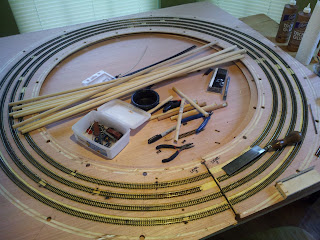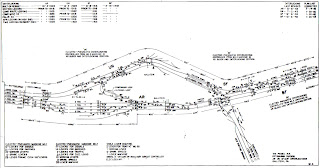Finally I can report some actual progress. I'm up to level three on the helix! Using some advice from Dave Smith at Railwire I also mastered soldering the joints on the steel Rapido track...
 |
| Level 2 |
 |
| Level 3 Underway |
 |
| Joint using the DKS method |
I know it's not earthshaking, but it has taken me a while to commit enough time to the project. I actually stayed with it for an entire 8 hours yesterday. Level 2 is done and I started on Level 3.
Makes me wonder if other model rails experience this. You haven't lost interest, but it seems like you find other things to keep you occupied. Not in the sense that you are busy, you just find yourself avoiding the issue. I know that John Allen had similar experiences while building the Gorre & Daphetid, it's mentioned in the Kalmbach book. If the "Great Poobah" hit a slump, I'm pretty sure it must be a common occurrence. There are times when I enter the garage and wonder, "what was I thinking?". I can imagine John doing the same thing. There must have been times he got to the bottom of the basement stairs and wondered.
It's not that the task is overwhelming. Any project is just a series of manageable steps (most of the time). The Allegheny Eastern just has a lot of steps. Since there is no real timetable for completion there are no deadlines. I would like to finish before my funeral, I'm pretty sure I can't take it with me. It would be nice to get the trains moving again and that shouldn't be too long (yea, right). Everything else might be a long time coming. Altoona (aka Keystone) wasn't built in a day.
As troublesome as these "pauses" in progress are, they almost always lead to improvements in the layouts design. It was during this last pause that I discovered the Sanford maps for the towns on the layout. I now know more about the sidings and industries that were served. This will require some modification of the plan, but ti will lead to some interesting operation. Furthermore, because the Sanford maps were from 1910 or so, almost all the industries were served by rail. This "backdating" creates switching opportunities. The crews (aka me) will be kept on their toes trying to perform their duties while avoiding the heavy traffic the Pennsy was known for.
The pause also revealed some issues I hadn't thought about. The curtain, for instance, that hides the storage under the layout doesn't work. This is particularly true in the "alcoves" at Horseshoe (aka Kittanning) Curve and Bennington (aka Remington). The idea was to be able to access the storage just by moving the curtain aside. The curtain is one continuous length of fabric. It needs to be in sections (and hemmed) so it can actually move out of the way. I can hear everyone saying "well, duh...yeah!). I mentioned before that I oft times miss the obvious.
I also found that some of the benchwork doesn't hold up. Along the approach to the curve I threw in some lumber to extend the real estate. Those pieces came off when I was retrieving some of the multitudinous Rubbermaid containers (the only intermodal freight the All East handles). While it did not affect track work, it would have affected scenery, especially if one or more grand kids decided to hang off it.
Not all was serendipitous, however. There was an incident where some of the benchwork at Altoona was "rearranged". Although most of the layout sections are equipped with wheels, they are not really portable. The entire assembly is bolted together with very large fasteners. While this makes it sturdy enough to withstand most stress, it is not quite equipped to be towed. I won't bother you with droll details. Suffice to say it involved a trailer, a 16 foot boot and some rope. That little Ranger of mine may not be the most powerful truck Ford made, but it can get the job done. Haven't fully accessed the damage yet, but it seems confined to the section joint near ALTO (aka KEY aka JK)
The ALTO tower reference brings to mind another effect of the "pause". After looking over several track charts I realized that the tower names, like the beloved ALTO and others, did not come into use until after 1941 (or there abouts). On the Middle Division chart for 1925, there is no ALTO. The two towers at that end of Altoona were designated JK and BO. It appears that there were two towers a little further east labeled FG and GD. On the 1945 chart for the same area these four towers are named SLOPE, ALTO, WORKS and ROSE. SOUTH tower just east of WORKS and ROSE doesn't show on the 1925 document. ANTIS, on the east end of the Altoona installion, was designated EF. Although I can no longer find it, I believe I had a chart of the area from 1940 or so that shows the older designations still in use. Anyway...I decided to use the older designations on the Allegheny Eastern. The newer designations will only be used as a reference for folks trying to keep track of all these changes...
 |
| Allegheny Eastern Plan March 25th 2013 |
One more change coming into affect is in the Spruce Creek (aka Harrowgate) area at the foot of the helix. I wasn't quite satisfied with the short bridges in this location. The Juniata River is a bit wider than previously represented. The All East version was more like a creek. I removed the roadbed and widened the gap about a foot so I could put in healthier length of arch bridge in each direction. I also intend to straighten the track across the bridges...
 |
| Harrowgate (Spruce Creek) |
The scene is "juxtapositioned". The bridges actually cross into the tunnels on the east side of Short Mountain, whereas they are on the west side on the All East...
 |
| Spruce Creek USGS Topographic 1931 |
I usually try to keep the orientation of the locations the same as the prototype, but the addition of the helix forced an "exception" here. If I could I would like to model the way the westbound tracks cross the river twice while the eastbound mains stay on the southwestern bank. Don't know if I can within the space available.
Well that's all the news from Keystone, Pennsylvania, where all the women are strong, all the men are good looking, and all the children are above average....Oh wait, that's Lake Wobegon. Sorry Garrison.
Regards,
Frank Musick
Chief Cook and Bottle Washer
 |
| Allegheny Eastern Railroad |




































